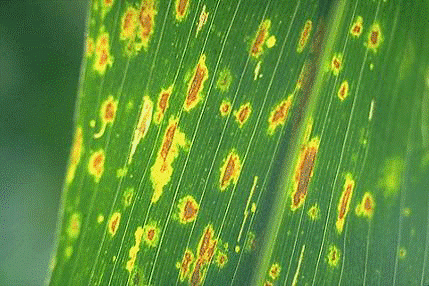By Doug Jardine, Extension Plant Pathologist
Tasseling has already begun in southeast Kansas and a few early planted fields in the south central part of the state. Over the next few weeks, corn in the rest of the state will be at the critical juncture for making fungicide application decisions for gray leaf spot management.
Gray leaf spot has already been found on corn this year in Pottawatomie and Harvey counties when the corn was only in the V7- V8 stage of development. In Harvey County, the levels were well above what you would expect to find at that stage of development.
Years of fungicide application research clearly demonstrate that the single best time to apply a fungicide to corn for gray leaf spot control is from VT-R1. A single application at V7–V8 will not hold up against late-season pressure and those who choose to put a fungicide down with the last herbicide treatment will most likely have to apply second cover at VT-R1 if there is any gray leaf spot pressure at all.
University fungicide trials also reveal that final disease severity plays a critical role in the magnitude and consistency of yield response to a foliar fungicide application. The tricky part is being able to predict before the VT-R1 stages what the disease pressure will be several weeks later. To make such a prediction, you need to consider “disease risk factors” and to scout for disease.

Disease risk factors include:
- Susceptibility level of corn hybrid. Seed companies typically provide information on the susceptibility of their hybrids to gray leaf spot in their catalogs. In general, hybrids that are more susceptible to fungal foliar diseases will have a greater response to a foliar fungicide (if disease pressure is high enough).
- Previous crop. Because gray leaf spot survives in corn residue, the risk of disease increases when corn is planted back into a field that was in corn the previous year.
- Weather. Rainy and/or humid weather generally is most favorable to gray leaf spot. In growing seasons when these conditions prevail, the risk for disease development increases.
- Field history. Some field locations may have a history of high foliar disease severity. Fields in river bottoms or low areas or those surrounded by trees may be more prone to having gray leaf spot.
Begin scouting for gray leaf spot in corn about 2 weeks before expected tassel emergence. Gray leaf spot is characterized by rectangular lesions that are 1-2 inches in length and cover the entire area between the leaf veins.
Early lesions are small, necrotic spots with yellow halos that gradually expand to full-sized lesions. Lesions are usually tan in color but may turn gray during foggy or rainy conditions. The key diagnostic feature is that the lesions are usually very rectangular in shape.
Current disease management guidelines suggest the following criteria for considering an application of foliar fungicide:
For susceptible hybrids (those with the lowest rating within a company’s lineup): If disease symptoms are present on the third leaf below the ear or higher on 50% of the plants examined.
For intermediate hybrids (those with an average rating within a company’s lineup): If disease symptoms are present on the third leaf below the ear or higher on 50% of the plants examined, if the field is in an area with a history of foliar disease problems, if the previous crop was corn, if there is 35% or more surface residue, and if the weather is warm and humid.
For resistant hybrids (those with the best rating within a company’s lineup): Fungicide applications generally are not recommended.
According to the data from Illinois corn fungicide trials, if at least 5% of the ear leaf area is affected by disease at the end of the season, a foliar fungicide applied between VT and R1 would likely have been beneficial. Using the disease risk factors and scouting observations collected just before tassel emergence will help you predict how severe disease may be several weeks after the VT-R1 stages, and help you decide whether to apply a foliar fungicide.






Post a comment
Report Abusive Comment